Three Stages of Distribution
The distribution of traditional Japanese printed books to Europe and the United States began before the opening of Japan to the world in 1854 and occurred in three stages. In the first, Westerners recognized Japan as having a cultured civilization, primarily because it had a script and its people were apparently literate, and although their gods were different, the notion of monotheism was evident in their worship of the Buddha. Comments in the catalogues of the early Dutch collectors of the 1820s reveal that they were actually quite impressed with Japanese accomplishments, both the quality of color printing—mostly seen in ukiyo-e prints—and the availability of printed books on all kinds of subjects. The early Dutch collectors were also surprised by the quality of etching, only recently developed as an art in Japan.
In the second period, late nineteenth-century collectors in Paris, aided by the British, discovered Japanese art and design through the circulation of Japanese books and albums, and they began to create extensive collections. Many of these collections, offered at public auctions in the 1920s, were appreciated by later generations of collectors. Institutional collections also were established in Boston, New York, and Chicago.1
In the third period, following World War II and continuing into the present, the collecting of Japanese books and albums has been concentrated among a rather small number of collectors, including Mme Huguette Berès (Sotheby’s auctions, 2002, 2003), Jack Hillier (to the British Museum), Sir Alfred Chester Beatty (1875–1968, now the Chester Beatty Library, Dublin), W. H. de Roos (Sotheby’s auction,1975), Charles H. Mitchell (1910–1986, in Japan 1948–83, to the New York Public Library), Donald and Mary Hyde (Christie’s auction, 1988), Dr. Richard Lane (partly to the Honolulu Academy of Arts, now the Honolulu Museum of Art), Heinz Kaempfer (1904–1986, Sotheby’s auction, 1986), Dr. Robert Ravicz (1921–1993, to the Chiba City Museum of Art),2 Dr. Gerhard Pulverer (to the Freer Gallery of Art, Smithsonian Institution, Washington, D.C.) (fig. 1), and a few others, the latest being Arthur and Charlotte Vershbow (to the Metropolitan Museum of Art, New York).
Dutch Traders in Japan
During the Edo period (1615–1868), after the Tokugawa shogunate restricted foreign trade and travel and expelled Europeans, only Dutch traders were allowed to remain, and only at Deshima, an island in the Nagasaki harbor. In the early nineteenth century, they began their collections of Japanese illustrated books. Among these early collectors were Jan Cock Blomhoff (1779–1853, chief merchant at Deshima, 1817–23) and his successor Johan de Sturler (1773–1855, chief merchant, 1823–26), as well as Johan van Overmeer Fisscher (1800–1848, various positions at Deshima, 1820–29). Probably the best-known collector was Philipp Franz von Siebold (1796–1866, medical doctor at Deshima, 1823–29).3
Inspiring their collections was the establishment of the Royal Cabinet of Curiosities in The Hague in 1816 by King William I, though De Sturler’s collection was eventually bequeathed to the Bibliothèque Nationale, Paris.4 Confined at Deshima, these collectors had only limited access to books and bookshops. Therefore they used the four annual court journeys from Nagasaki to the capital city of Edo to enrich their collections. Whereas Blomhoff made most of his acquisitions, primarily ehon (picture books), in Edo, Fisscher aimed for a more comprehensive library, with holdings like those that might be represented in the library of a contemporary Japanese bunjin (literatus) by combining what was available in both Edo and Osaka (fig. 2). Siebold depended largely on what his students could procure for him, mostly enriching his library with books from Osaka rather than Edo.
Today Blomhoff and Fisscher are largely forgotten as collectors because Siebold borrowed most of their collections in 1836 and simply refused to return them, in spite of reminders signed by no less than the Dutch minister of interior affairs, even as late as the 1850s. Thus Siebold is now widely credited for having bought the then available first ten volumes of the Hokusai manga (actually a Fisscher acquisition), quite a few other ehon by the artist Katsushika Hokusai (1760–1849) (most of them acquired by Blomhoff), the ryakugashiki albums by Kuwagata Keisai (1764–1824) (fig. 3, fig. 4) in which the artist proposed an innovative style of abbreviated drawing (again from the Blomhoff Collection), and even the encyclopedic Wakan sanzai zue (eighty-one volumes compiled by the Osaka doctor Ryōan) (another Fisscher acquisition). The Blomhoff Collection of books was acquired by the Royal Cabinet in 1826, and the Fisscher and Siebold Collections in 1831. Consequently, it is hard to understand why around 1927 the librarian of the National Museum of Ethnology, the direct successor of the Royal Cabinet, told Charles Vignier (1863–1934) that the Siebold Collection was acquired in 1845. But then, the Bibliothèque Nationale at Paris was not sure when exactly the “fonds Siebold” entered the library, around 1830, the staff believed, where it was, much to Vignier’s astonishment, classified as part of the Chinese collection.5
In 1845, when Johann Joseph Hoffmann (1805–1878) issued a catalogue of the Siebold Collection, including most of the borrowed items from the Blomhoff and Fisscher Collections, the number totaled some 615 titles, at least one-third of which had not been acquired by Siebold.6 Yet Siebold would prove to be one of the earliest suppliers of Japanese books to various institutions. He donated works to the Bibliothèque Nationale, and in 1868 his son, Alexander von Siebold (1846–1911), sold 1,088 Japanese books that his father had collected in Japan, in the years 1859 to 1862, to the British Library, probably because he felt in need of money (fig. 5). That, however, was already after the opening of Japan in 1854.
Most surprisingly, the books available in both the Royal Cabinet in The Hague and in the Bibliothèque Nationale in Paris apparently failed to make any real impression on the public. It is worthy of note that Hoffmann chose to publish the catalogue of the Dutch collections of Japanese books in Latin: certainly such a learned audience was not interested in the pictures. Yet even later, after the opening of Japan, more collections of Japanese illustrated books found their way into Western institutions. During his second journey to Japan in 1859–62, Siebold collected books that are now in the National Museum of Ethnology, Munich. A collection of some 160 books acquired by Koenraad Gratama (1831–1888, in Japan 1866–71) is now in Leiden, and a collection of more than 1,000 books formed by Adolf Nordenskiöld (1832–1901, in Japan 1871) is now in the Royal Library in Stockholm.
Collectors in Paris
Only in the final decades of the nineteenth century were Japanese illustrated books recognized in the West as works of art, and the discovery is described in 1900 by Théodore Duret (1838–1927) in the preface to the catalogue of his collection donated to the Bibliothèque Nationale.7 This second period in the collecting of Japanese illustrated books began with a journey. As Duret observed, no one had ever seen more than the few works of Japanese art on display at the World Exposition of 1867. When he traveled to Japan in 1871–72 with Henri Cernuschi (1821–1896), who would start collecting bronzes as the foundation for his Paris museum, the Musée Cernuschi, Duret decided to look for books and albums like those he had just seen at the exposition. But then, not knowing any artist’s name or the title of any book, he had the greatest difficulty trying to explain to bookshop proprietors what he was looking for, especially as such shops had no windows displaying their wares and kept their books stacked away in the back. Returning with a modest group of works by Hokusai and some of his contemporaries, Duret was satisfied with his purchases, not having the slightest idea about what else there could be (fig. 6). Even after 1873, when Edmond de Goncourt (1822–1896) and Philippe Burty (1830–1890) started collecting prints and albums, all that the art dealers brought with them to Paris were bronzes, lacquerware, porcelain, and netsuke—those small carvings from which the Japanese would suspend their tobacco pouches and medicine boxes—no books.
Only after traveling to London and meeting Dr. William Anderson (1842–1900), who had taught surgery in Japan from 1873 to 1880, did Duret begin to get some notion of the history of Japanese art. Anderson not only had a large collection of paintings, prints, and albums, but he had also started making notes on the artists.8 Yet, as Duret pointed out in his preface, seven years in Japan had not sufficed for Anderson to acquire even one work by Hishikawa Moronobu or one print by Torii Kiyonaga. Their names were unheard of in Paris when Duret began to sing their praise after one of his regular visits to Anderson. Not until 1883 were works by these artists brought to the West, upon the return of Ernest Satow (1843–1929), who had been with the British Embassy in Japan (1862–69 and 1870–83). By then the Parisian scene had also changed. Louis Gonse (1846–1921) published his Art japonais in 1883,9 assisted by his friend, the dealer Hayashi Tadamasa (1853–1906), who, like his colleague Siegfried Bing (1838–1905), had hired an agent in Japan who would procure whatever they, or their clients, desired. Eventually Duret acquired some twenty albums illustrated by Moronobu, a few in multiple copies. Other collectors of Moronobu include Émile Javal (18 albums in the 1928 sale of his collection), Charles Haviland (13 albums in his 1925 sale), Tadamasa Hayashi (11 albums in his 1902 sale), and Charles Gillot (1853–1903) (10 albums in his 1904 sale), and Louis Gonse (10 albums in his 1926 sale). Indeed, these are the major collectors of Japanese illustrated books in Paris prior to World War II.
In fact, the collection made by Duret in the short time before he donated it to the Bibliothèque Nationale in 1900 is remarkably well balanced, including most major Japanese traditions of painting and probably most comprehensive in works by Hokusai, with quite a few alternative impressions or editions as well as a good selection of the artist’s early work in illustrated novels. Duret’s catalogue was regularly cited as a reference in the auctions of the major collections that took place in the 1920s, when this first generation of collectors passed away. They had together discovered this new art and shared their enthusiasm for it in regular meetings hosted by one of the group. In addition to Gonse and Gillot and others named above were Raymond Koechlin (1860–1931, sale 1926), Alphonse Isaac (1858–1924, sale 1925), Gaston Migeon (1861–1930) of the Musée du Louvre, and Henri Vever (1854–1942, sale 1948); sometimes James McNeill Whistler (1834–1903) joined them. For these early aficionados of Japanese art, books and albums were only part of a surprising new imagery comprised of such diverse objects as Buddhist sculpture, bronzes, tea bowls, and lacquered writing boxes (fig. 7).
The auction catalogues of these collections also bear witness to the increasing expertise of Vignier, who was responsible for the catalogues of most Drouot sales of Japanese arts in the 1920s, later assisted by Mme Marianne Densmore. Vignier’s precise annotations distinguish variant impressions and later editions and even contain references to copies in other collections, providing documentation that remains valuable today. In the 1927 auction catalogue of the collection of Émile Javal, Vignier made a first attempt at distinguishing the various editions of the Hokusai manga (fig. 8).10 His awareness of the existence of various editions, even carrying the same date, and his efforts to discern what the edition princeps would be like inspired him to write a severe critique of Louise Norton Brown’s (1865–1923) Block Printing and Book Illustration in Japan (1924),11 accusing her of never having opened any of the books she listed. In the same critique, which became the “preliminary notes” to the 1927 Javal auction catalogue, Vignier also expressed fears that Americans would strike and buy the best at the highest prices and that France would consequently lose some of the relics it had discovered first.12
Indeed, in his foreword to Kenji Toda’s landmark catalogue of the books in the Ryerson Library of the Art Institute of Chicago, Frederick Gookin (1853–1936) mentioned the “purchases at the Javal and Odin sales in Paris.”13 Otherwise, the history of the Ryerson Collection is summed up as originating with a few volumes that Martin Ryerson (1856–1932) happened to pick up14 and with a selection made by Gookin from several hundred books from a private library bought in Tokyo by a Japanese dealer in Chicago as its first substantial acquisition in 1913. Later, in 1923 and 1926, almost the complete collections made in Japan by Ernest Fenollosa (1853–1908, in Japan 1878–90) and by Louise Norton Brown (in Japan from 1913?) would follow. Interestingly, the Fenollosa books came by way of the well-known collector Hamilton Easter Field (1873–1922).15 However, Gookin also gave some 200 books to the Art Institute, as did various other donors, making the total collection now some 1,800 volumes (fig. 9).
On the East Coast, the 1911 gift of 40,000 objects of Japanese art by William Sturgis Bigelow (1850–1926, in Japan 1882–89) established the collection of Japanese books at the Boston Museum of Fine Arts. There are two different stories about the origins of the Spencer Collection at the New York Public Library. According to the most recent version, the library made its major acquisitions in the field of Japanese manuscripts (some 300) and printed books (some 1,500) just before and after World War II, buying mainly from the Tokyo antiquarian bookshop of Sorimachi Shigeo.16 But Sorimachi himself wrote that when he first visited the library in 1965, he became “increasingly impressed by the admirable quality of the Collection”; he visited the library “for one whole week,” “every day.”17
In any case, in the mid-1970s, the library acquired en bloc the collection of Charles H. Mitchell. It included some 750 printed books, a real coup in those days. Mitchell had made his collection buying and exchanging, and he was always trying to obtain better copies and finer impressions so as to improve his collection. He worked closely with fellow book collectors, such as Richard Lane in Kyoto and Jack Hillier in London, as well as with many others. With the assistance of Ueda Osamu, he compiled something far more than just a catalogue of his own collection, as he initially intended. His publication became, rather, a compilation of all the books that might have figured in his collection, bringing together notes on some 930 titles, in great detail.18
Collecting after World War II
Typical of the final stage of collecting (fig. 10), which began after World War II, are close relations among the collectors of books, similar to those of the early group of Parisian collectors but now to be found in Europe (Huguette Berès, Nathan Chaikin, Kenneth Gardner, Jack Hillier, Owen Holloway, Heinz Kaempfer, and Lawrence Smith), in the United States (James B. Austin, Jan Fontein, Donald Jenkins, and Kenji Toda), in Canada (David Waterhouse), and in Japan (Hayashi Yoshikazu, Richard Lane, Oka Isaburō, and Suzuki Jūzō)—just to cite from Mitchell’s acknowledgments. Not all were avid collectors of Japanese illustrated books, and some have already been mentioned. Yet all were convinced of the necessity to better understand what is a first edition, what qualifies as a good impression, and where the necessary information can be found.
Bibliographic practice is a Western notion that Japan has only gradually embraced.19 Western collections tend to be much more easily and directly accessible than those in Japan, but various overseas cataloguing projects have been launched by quite a number of Japanese institutions, and some have been carried out by institutions in the West. One minor problem seems to be that it is apparently impossible to agree on a uniform format for cataloguing any book, starting with whether it should be catalogued by the title on its cover or by the title given in the preface or the table of contents. However, the biggest problem is that there is not yet a single database of holdings.20 If there were such a database, it would be easy to complete the work started in the 1920s by Charles Vignier and continued by Charles Mitchell in his 1972 publication.
Footnotes
These include the Ryerson Collection at the Art Institute of Chicago, and others. A 2002 survey, conducted among American institutions by the Subcommittee on Japanese Rare Book Cataloging Guidelines under the CEAL Committee on Japanese Materials, lists forty-three collections that collectively hold at least 57,888 volumes of old and rare Japanese printed books and manuscripts.
Illustrations for this essay represent books most favored by the collectors discussed. They are placed in relevant paragraphs except where there is a specific relationship to a title.
This survey of early collectors ignores some incidental items that can be traced back to earlier acquisitions, some from the time the British still had an office at Hirado, but most through the Dutch at Deshima.
It is most likely that there were earlier collections that were simply dispersed and scattered in the absence of some institutional destination.
Charles Vignier records the librarian’s response as “Selon toute probabilité la Mangwa est entrée au Musée en 1845. C’est au moins à cette date qu’une collection considérable a été acheté à von Siebold.” Charles Vignier and Marianne Densmore, Catalogue de la Bibliothèque de Livres japonais Illustrés appartenant à M. Émile Javal, première partie (Paris, 1927), 45.
Philipp Franz de Siebold and Johann Joseph Hoffmann, Catalogus Librorum et Manuscriptorum Japonicorum a Ph.Fr. de Siebold Collectorum, Annexa Enumeratione Illorum, qui in Museo Regio Hagano Servantur (Leiden: by the author [Siebold], 1845).
Théodore Duret, Livres et Album Illustrés du Japon (Paris: Ernest Leroux, 1900), i–ix.
William Anderson’s collection of approximately 2,000 illustrated books was donated to the British Library, and he authored the then most authoritative Pictorial Arts of Japan: With a Brief Historical Sketch of the Associated Arts, and Some Remarks upon the Pictorial Art of the Chinese and Koreans, 2 vols. (London: Sampson Low, Marston, Searle, and Rivington; Boston: Houghton, Mifflin, 1886).
Louis Gonse, Art japonais, 2 vols. (Paris: A. Quantin, 1883).
Vignier and Densmore, Catalogue de la Bibliothèque de Livres japonais Illustrés, 37–45.
Louise Norton Brown, Block Printing and Book Illustration in Japan (London: Routledge and Sons; New York, E. P. Dutton, 1924).
Vignier, in the 1927 catalogue of the collection of Émile Javal, severely criticizes major mistakes in Brown’s book. For example, in regard to her efforts to distinguish the earliest impression of any work, he wrote, “Ce travail-là, Mrs Brown n’en a pas le soupcon, puisqu’elle ne voit pas la differénce d’une edition modern à une ancienne. Fleur!” (p. 1), and he also discussed at length her mistaken origins of book printing in Europe as well as her statements on the beginning of color printing in Japan (p. 2). In the preface to Brown’s book, Block Printing and Book Illustration in Japan, W.W.S. asserted that she “possessed a knowledge of Japanese illustration which will never be rivalled in Europe or America.”
Frederick W. Gookin, foreword to Kenji Toda, Descriptive Catalogue of Japanese and Chinese Illustrated Books in the Ryerson Library of the Art Institute of Chicago (Chicago: Lakeside Press, 1931), iv. Kenji Toda is described as “an artist attached to the Zoology Department of The University of Chicago.” Ibid., iii.
Gookin remarked in the foreword, “This collection began, in a small way, a good many years ago, when Mr. Ryerson was attracted by a few volumes he chanced to come across.” Toda, Descriptive Catalogue of Japanese and Chinese Illustrated Books, iii.
Unfortunately, as is not well known, the Toda catalogue leaves out most of the Ernest Fenollosa and Louise Norton Brown material. It is hoped that this material will soon be available.
See Paul LeClerc, president of the New York Public Library, foreword to Roger S. Keyes, Ehon: The Artist and the Book in Japan (Seattle and London: New York Public Library and University of Washington Press, 2006), 8.
Sorimachi Shigeo, Catalogue of Japanese Illustrated Books and Manuscripts in the Spencer Collection of the New York Public Library (Tokyo: Kōbunsō, 1978), 2.
Charles H. Mitchell, The Illustrated Books of the Nanga, Maruyama, Shijo and Other Related Schools of Japan: A Biobibliography (Los Angeles: Dawson’s Book Shop, 1972).
When I first asked Suzuki Jūzō about any Japanese study on Edo period books, he could suggest only Konta Yōzō’s Edo no honyasan (1977). Today, there is a much more extensive literature in Japan, though mostly descriptive, hardly critical or interpretive.
In Japan, the National Institute of Japanese Literature has compiled an online Union Catalogue of Early Japanese Books, and a European Union Catalogue of Early Japanese Books is under development.

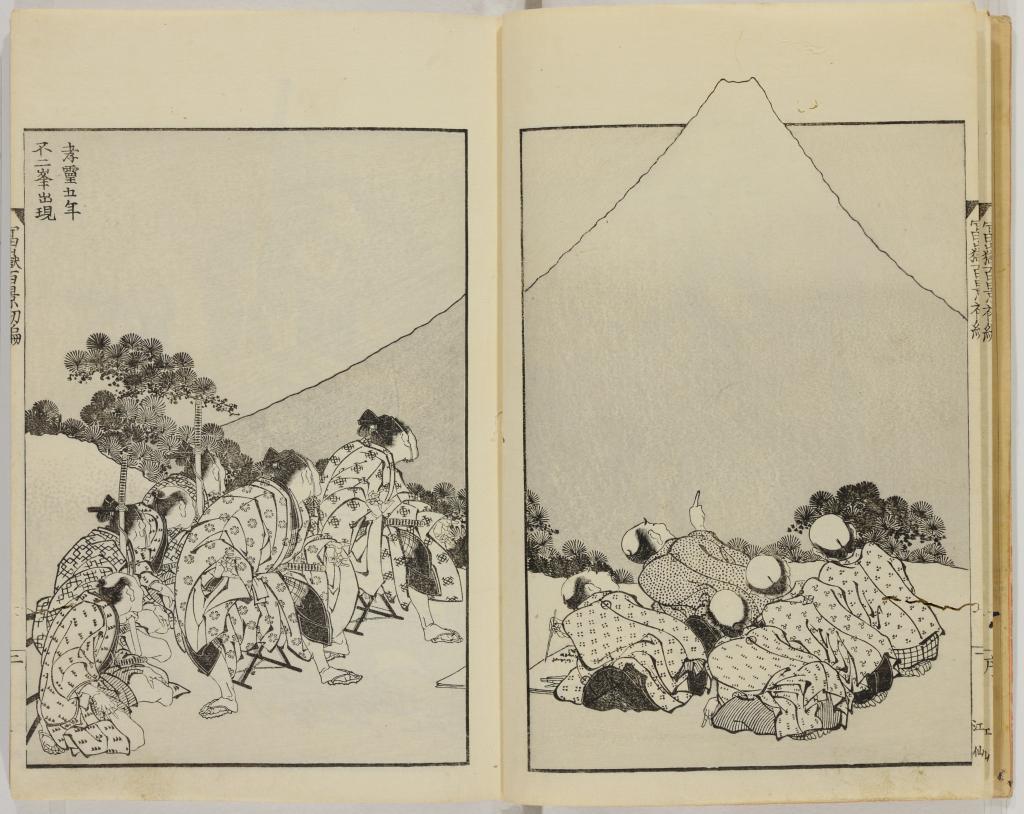
Fugaku hyakkei 富嶽百景
Artist: Katsushika Hokusai (1760–1849)
Edo period, 1834 (Tenpō 5), volume 1
Volume 1 of 3; fukurotoji binding; woodblock printed; ink on paper; paper covers
22.9 x 15.8 x 1 cm
Freer Gallery of Art, FSC‑GR‑780.246.1
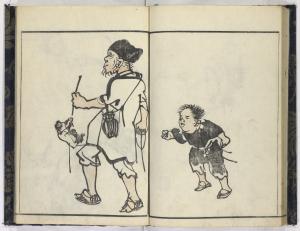
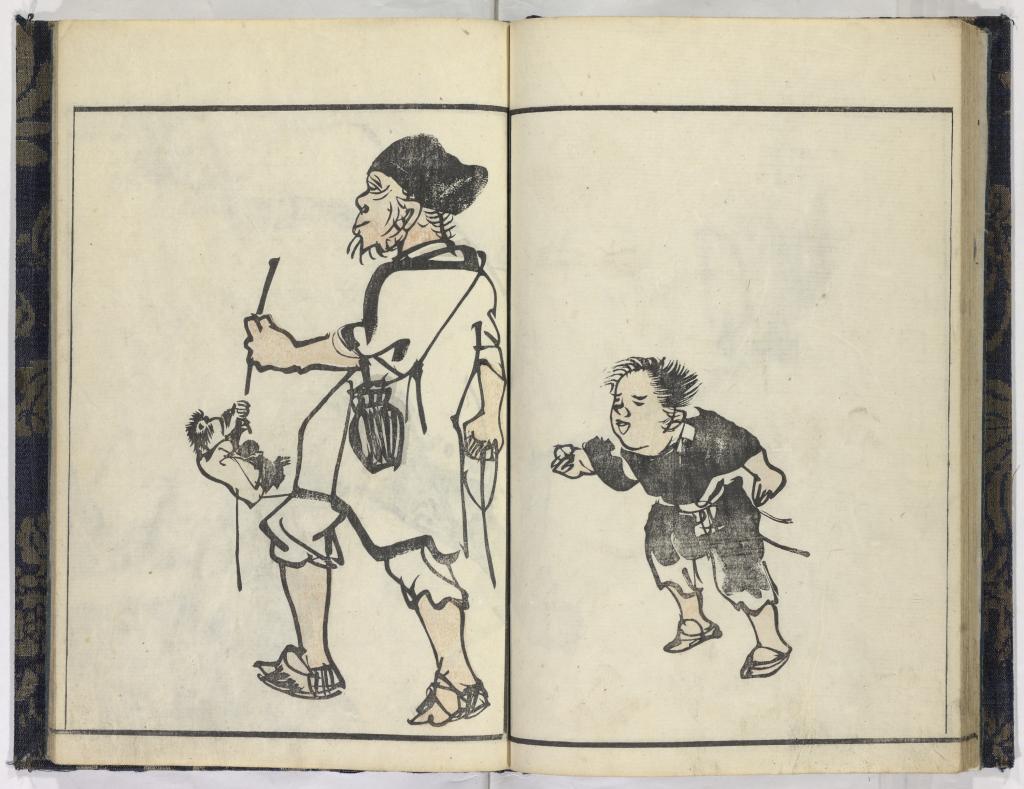
Bunpō gafu 文鳳画譜
Artist: Kawamura Bunpō (1779–1821)
Edo period, 1807 (Bunka 4), winter
1 volume; fukurotoji binding; woodblock printed; ink and color on paper, paper covers
26.3 x 17.9 x 1.5 cm
Freer Gallery of Art, FSC‑GR‑780.278
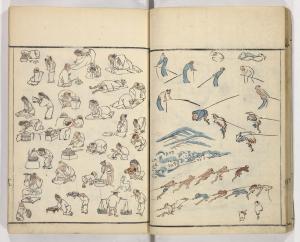
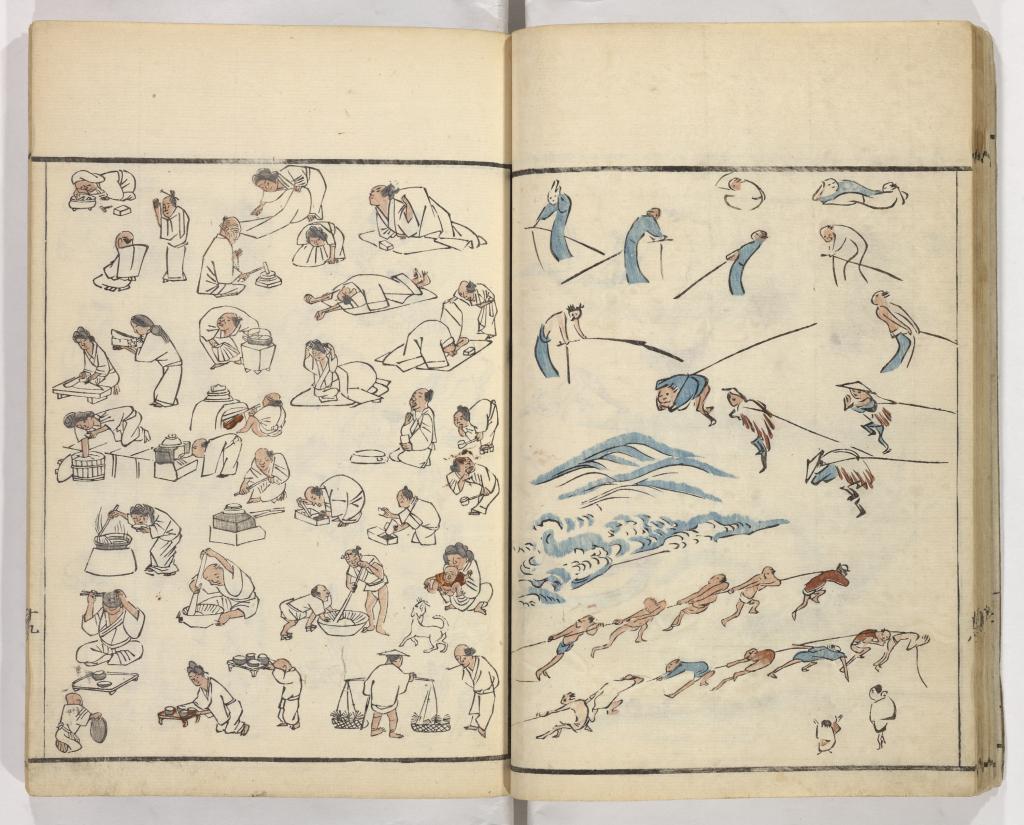
Ryakugashiki 略画式
Artist: Kitao Masayoshi (1764–1824)
Edo period, 1795 (Kansei 7), 4th month
1 volume; fukurotoji binding; woodblock printed; ink and color on paper; paper covers
26.4 x 18.1 x 0.9 cm
Freer Gallery of Art, FSC‑GR‑780.335
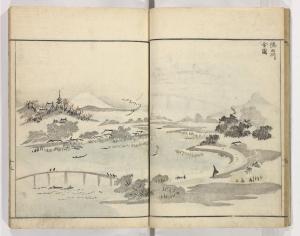
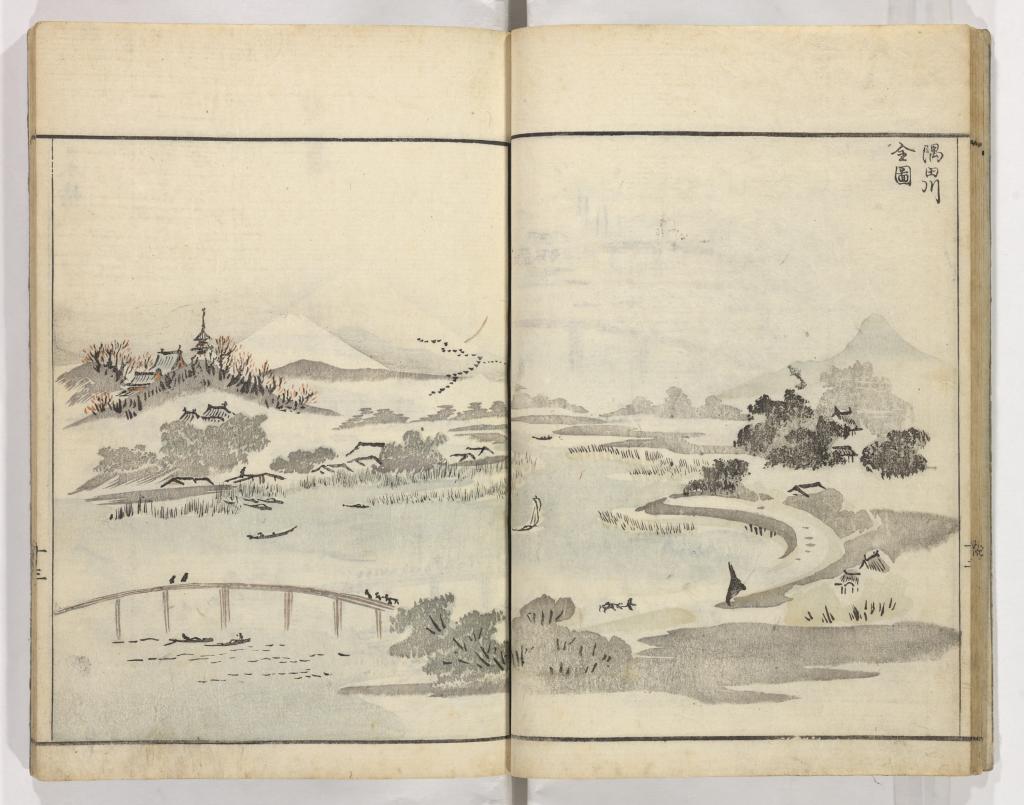
Sansui ryakugashiki 山水略画式
Artist: Kitao Masayoshi (1764–1824)
Edo period, 1800 (Kansei 12), 1st month
1 volume; woodblock printed; ink and color on paper; paper covers
26.3 x 18.1 x 1 cm
Freer Gallery of Art, FSC‑GR‑780.337
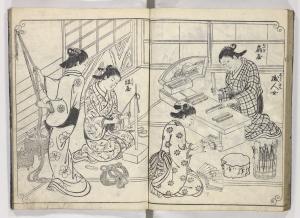
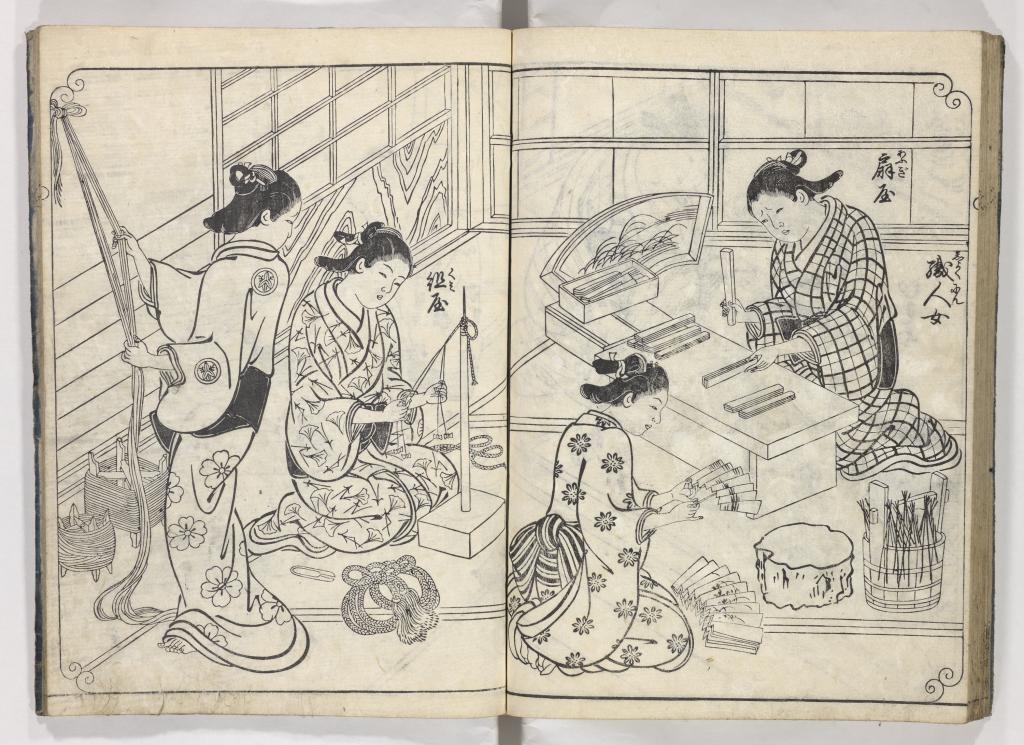
Hyakunin jorō shinasadame 百人女郎品定
Artist: Nishikawa Sukenobu (1671–1751)
Edo period, 1723 (Kyōhō 8), 1st month
Volume 1 of 2 fukurotoji binding; woodblock printed; ink on paper; paper covers
26.6 x 19.5 x 1.2 cm
Freer Gallery of Art, FSC‑GR‑780.441.1
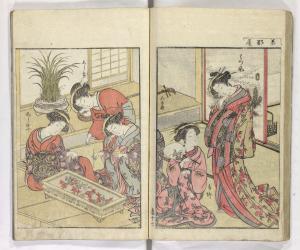
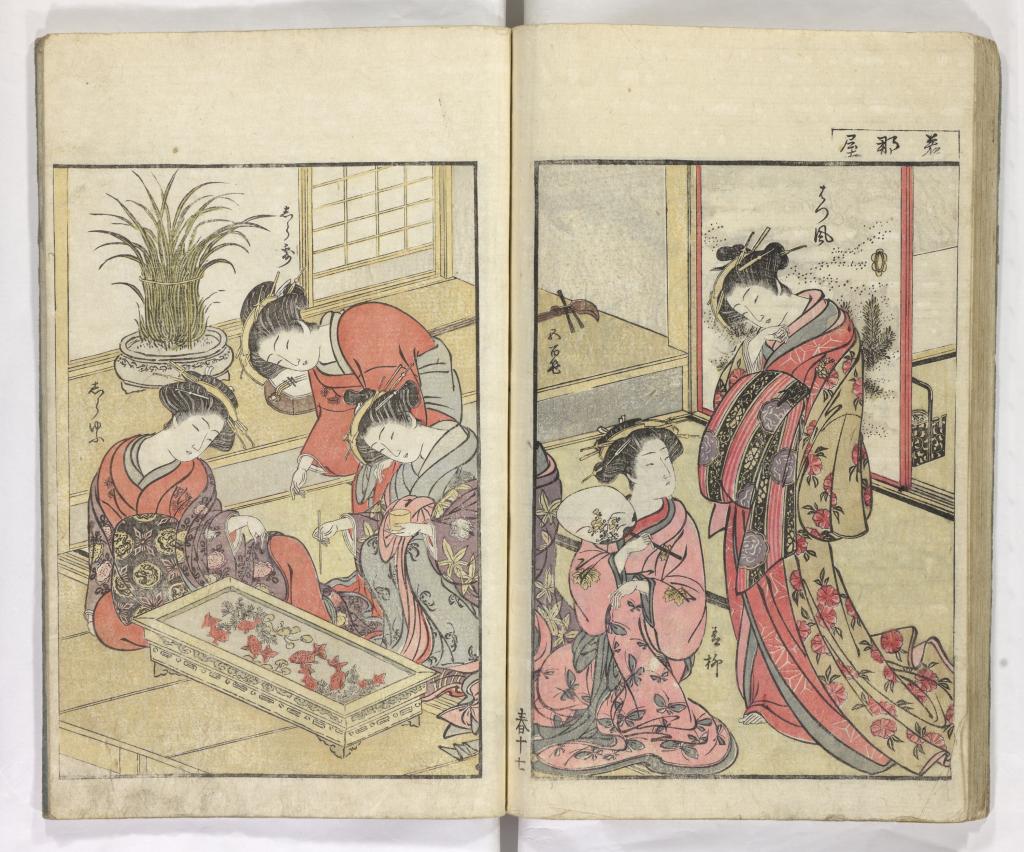
Seirō bijin awase sugata kagami 青楼美人合姿鏡
Artist: Kitao Shigemasa (1739–1820)
Artist: Katsukawa Shunshō (1726–1792)
Edo period, 1776 (An’ei 5), 1st month
Volume 1 of 3; fukurotoji binding; woodblock printed; ink and color on paper; paper covers
27.9 x 18.6 x 1 cm
Freer Gallery of Art, FSC‑GR‑780.167.1

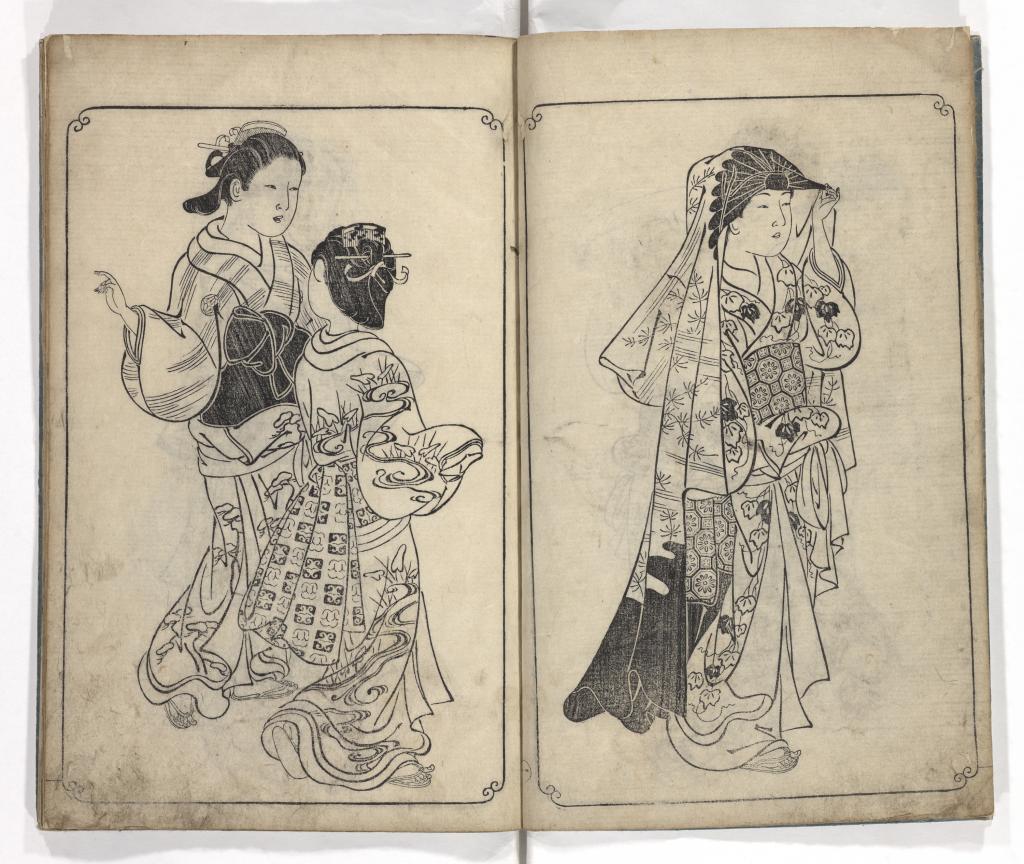
Ehon Asakayama 絵本浅香山
Artist: Nishikawa Sukenobu (1671–1751)
Edo period, 1739 (Genbun 4), 1st month
1 volume; woodblock printed; ink on paper; paper covers
27.4 x 17.9 x 0.4 cm
Freer Gallery of Art, FSC‑GR‑780.444
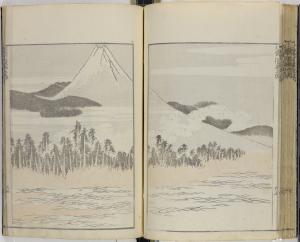

Hokusai manga 北斎漫画
Artist: Katsushika Hokusai (1760–1849)
Edo period, 1816 (Bunka 13)
Volume 5 of 15; fukurotoji binding;woodblock printed; ink and color on paper; paper covers
22.9 x 15.9 x 1 cm
Freer Gallery of Art, FSC‑GR‑780.233.5
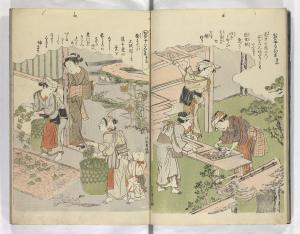
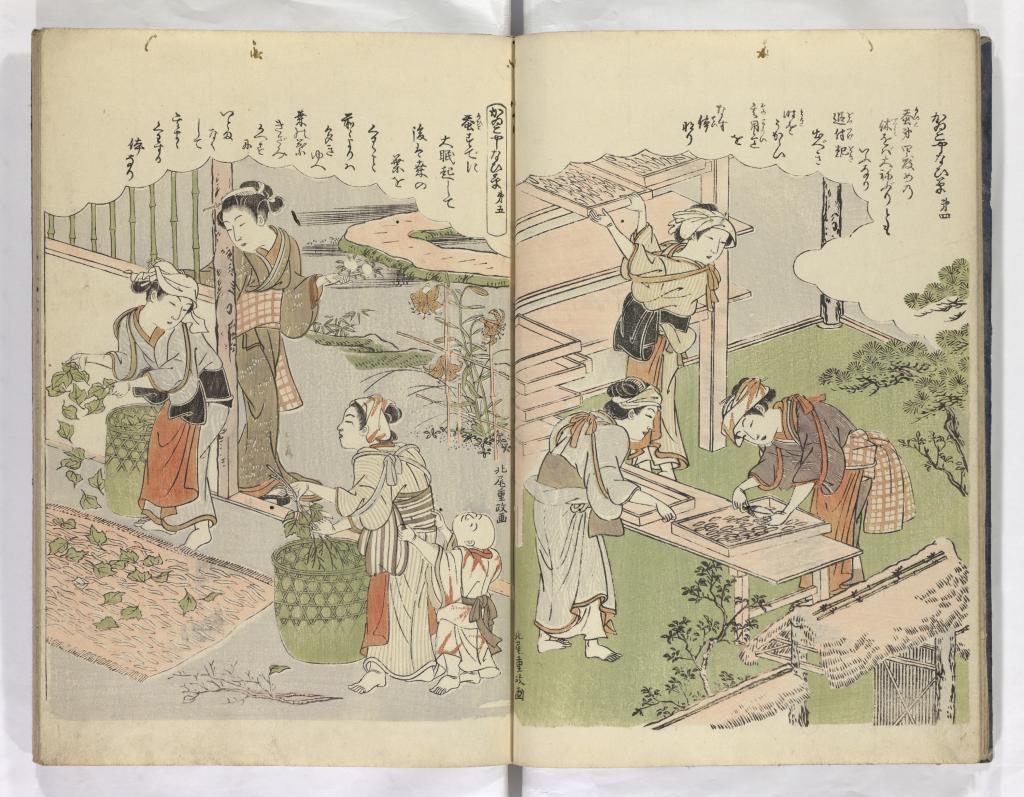
(Kaiko yashinai zue) Ehon takara no itosuji (養会)画本宝能縷
Artist: Katsukawa Shunshō (1726–1792)
Artist: Kitao Shigemasa (1739–1820)
Edo period, 1786 (Tenmei 6), 1st month
1 volume; fukurotoji binding;woodblock printed; ink and color on paper; paper covers
28.8 x 20.2 x 0.7 cm
Freer Gallery of Art, FSC‑GR‑780.168
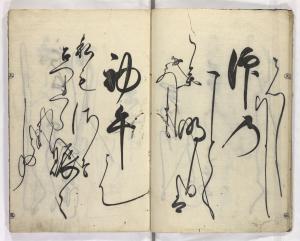
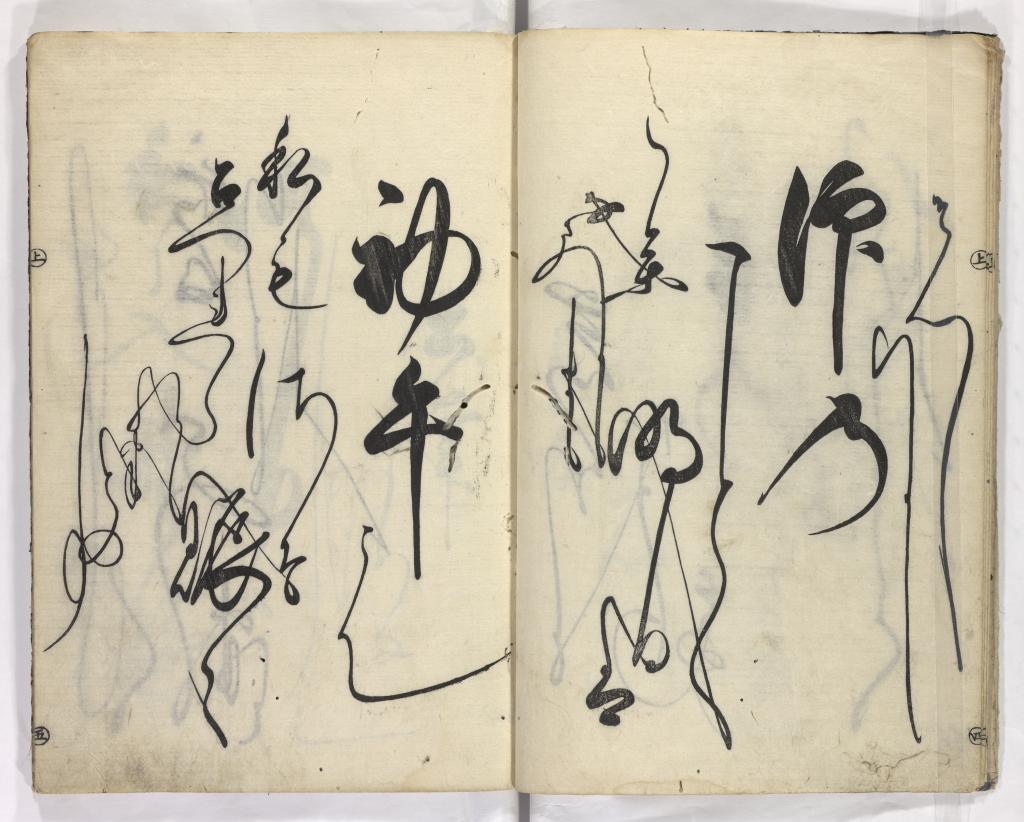
Chiyomigusa 千代見草
Artist: Nishikawa Sukenobu (1671–1751)
Edo period, 1733 (Kyōhō 18), 1st month
Volume 1 of 3; fukurotoji binding; woodblock printed; ink on paper; paper covers
28 x 19.2 x 0.7 cm
Freer Gallery of Art, FSC‑GR‑780.453.1
